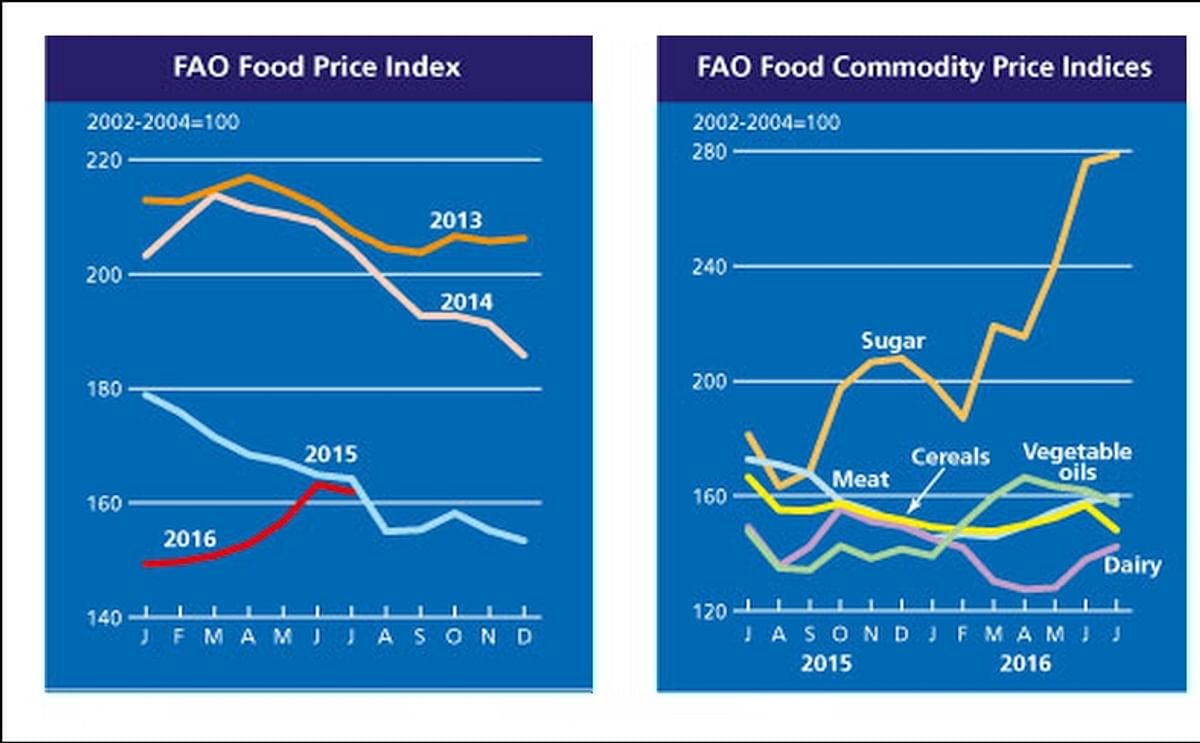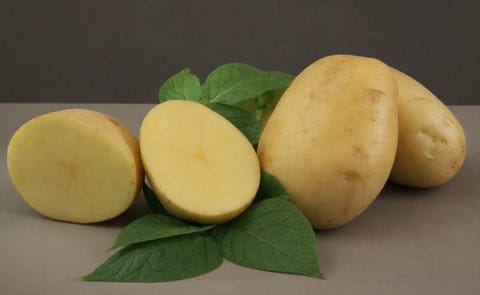The FAO Food Price Index (FFPI) - an indicator of global food prices - averaged 161.9 points in July 2016, 1.3 points (0.8 percent) below June and 1.4 percent below the corresponding month last year.
主标签
The FAO Food Price Index went down in July

The FAO Food Price Index (FFPI) - an indicator of global food prices - averaged 161.9 points in July 2016, 1.3 points (0.8 percent) below June and 1.4 percent below the corresponding month last year. The modest decline in July that followed five consecutive monthly increases was largely caused by drops in international quotations of grains and vegetable oils, more than offsetting firmer dairy, meat and sugar prices.
The FAO Cereal Price Index averaged 148.1 points in July, down 8.8 points (5.6 percent) from June and 11 percent below the July 2015 level. Among the major cereals, maize values dropped sharply as weather conditions in the key growing regions of the United States proved more favourable than was predicted. Wheat prices also fell in July mainly on very large world supplies and, in particular, prospects for abundant export availabilities from the Black Sea region. By contrast, rice prices strengthened somewhat, as dwindling availabilities underpinned Basmati and long-grain quotations.
The FAO Vegetable Oil Price Index averaged 157.4 points in July, down 4.6 points (2.8 percent) from June and falling for the third consecutive month. The slide was mainly on account of palm oil, whose price dropped to a 5-month low as regular rainfall underpinned a seasonal recovery in production in Southeast Asia whilst global import demand remained subdued. International prices for soy, sunflower and rapeseed oil also eased on better than earlier anticipated supply prospects, further contributing to the fall in the index.
The FAO Dairy Price Index averaged 142.3 points in July, up 4.3 points (3.2 percent) from June. Prices rose for all the dairy commodities that compose the Index, in particular for butter. Yet, they remain at very low levels compared to recent years. In the face of lacklustre international demand, especially for milk powders, the EU is considering measures to foster a reduction of milk output, which rose by 4.4 percent in the year to May. Meanwhile, in Oceania, generally favourable rainfall at the start of the 2016/17 milk year has improved yield prospects.
The FAO Meat Price Index averaged 159.9 points in July, 2.0 points (1.3 percent) higher than its revised June value. All meat products covered by the Index saw prices firm, in particular pigmeat, underpinned by limited availabilities. Notable developments include a shortage of pigs for slaughter and lighter slaughter weights in the EU and reduced output of sheep and bovine meat in Oceania, caused by herd rebuilding. At the same time, international demand for meat remains firm, supported by a recovery in purchases by China, and sustained imports by several countries elsewhere in Asia.
The FAO sugar price index averaged 278.7 points in July, up 2.7 points (1.0 percent) from June. International sugar prices were largely influenced by movements in the Brazilian currency (Real), which strengthened against the United States dollar (up by around 4 percent in July compared with June). A stronger Real is supportive for international sugar prices because it limits Brazilian sugar exports to the world market as producers prefer to process sugarcane into ethanol for local sale.
The FAO Cereal Price Index averaged 148.1 points in July, down 8.8 points (5.6 percent) from June and 11 percent below the July 2015 level. Among the major cereals, maize values dropped sharply as weather conditions in the key growing regions of the United States proved more favourable than was predicted. Wheat prices also fell in July mainly on very large world supplies and, in particular, prospects for abundant export availabilities from the Black Sea region. By contrast, rice prices strengthened somewhat, as dwindling availabilities underpinned Basmati and long-grain quotations.
The FAO Vegetable Oil Price Index averaged 157.4 points in July, down 4.6 points (2.8 percent) from June and falling for the third consecutive month. The slide was mainly on account of palm oil, whose price dropped to a 5-month low as regular rainfall underpinned a seasonal recovery in production in Southeast Asia whilst global import demand remained subdued. International prices for soy, sunflower and rapeseed oil also eased on better than earlier anticipated supply prospects, further contributing to the fall in the index.
The FAO Dairy Price Index averaged 142.3 points in July, up 4.3 points (3.2 percent) from June. Prices rose for all the dairy commodities that compose the Index, in particular for butter. Yet, they remain at very low levels compared to recent years. In the face of lacklustre international demand, especially for milk powders, the EU is considering measures to foster a reduction of milk output, which rose by 4.4 percent in the year to May. Meanwhile, in Oceania, generally favourable rainfall at the start of the 2016/17 milk year has improved yield prospects.
The FAO Meat Price Index averaged 159.9 points in July, 2.0 points (1.3 percent) higher than its revised June value. All meat products covered by the Index saw prices firm, in particular pigmeat, underpinned by limited availabilities. Notable developments include a shortage of pigs for slaughter and lighter slaughter weights in the EU and reduced output of sheep and bovine meat in Oceania, caused by herd rebuilding. At the same time, international demand for meat remains firm, supported by a recovery in purchases by China, and sustained imports by several countries elsewhere in Asia.
The FAO sugar price index averaged 278.7 points in July, up 2.7 points (1.0 percent) from June. International sugar prices were largely influenced by movements in the Brazilian currency (Real), which strengthened against the United States dollar (up by around 4 percent in July compared with June). A stronger Real is supportive for international sugar prices because it limits Brazilian sugar exports to the world market as producers prefer to process sugarcane into ethanol for local sale.
Like to receive news like this by email? Join and Subscribe!
Get the latest potato industry news straight to your WhatsApp. Join the PotatoPro WhatsApp Community!
精选企业
Sponsored Content
Sponsored Content
Sponsored Content
Sponsored Content









